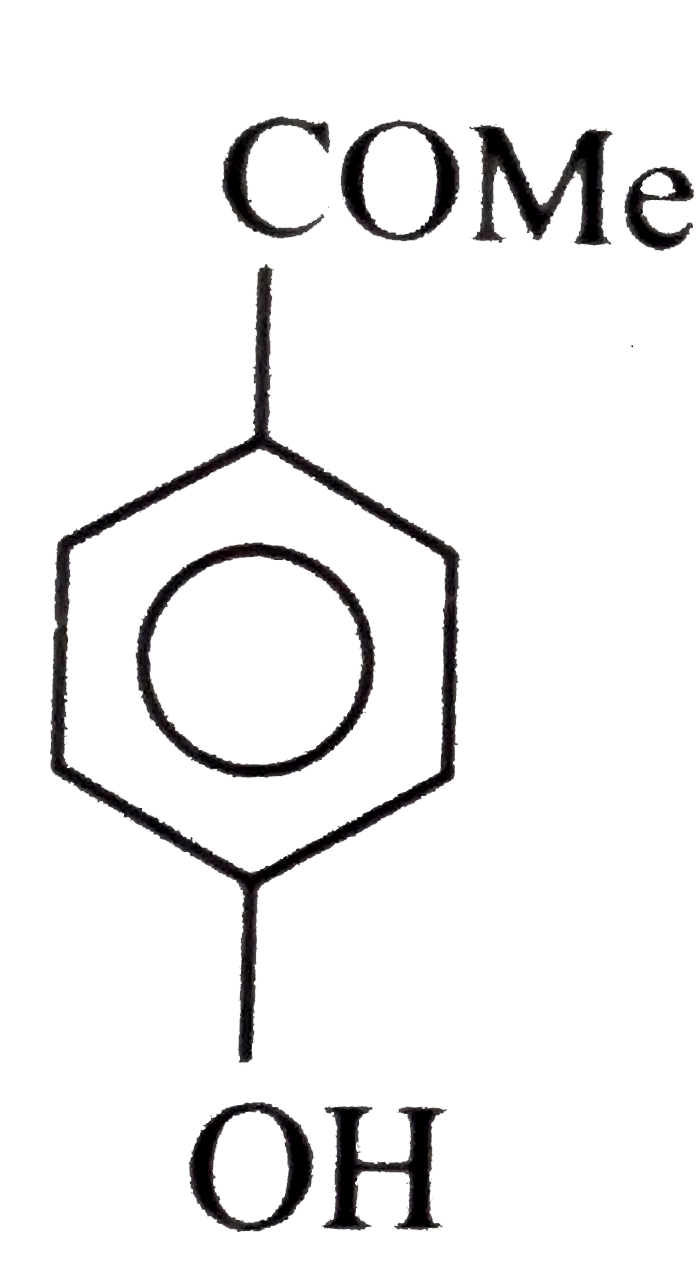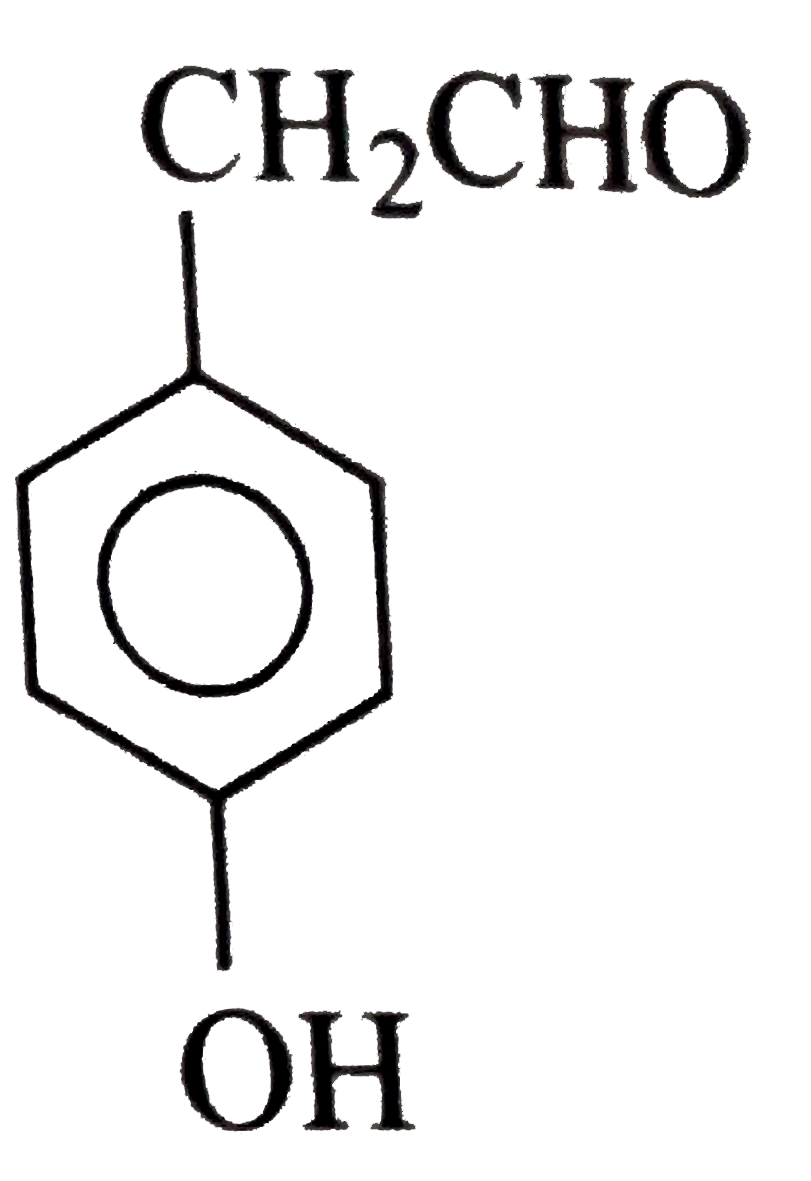Five isomeric p-subsituted aromatic compounds (A) to (E ) with molecular formula C8H8O2 are given for identifyication. Based on the following observition, give the strucctures of the compounds.
i. Both (A) and (B) form a silver mirror with Tollens reagent, (B) also gives a positive test with neutral FeCl3 solution.
ii. (C ) gives positive iodoform test.
iii. (D) is readily extracted in aqueous NaHCO3 solution.
iv. (E ) on acid hydrolysis gives 1,4-dihydroxy benzene. Compound (E ) is:




The correct Answer is:C
To identify the structures of the five isomeric p-substituted aromatic compounds (A) to (E) with the molecular formula C8H8O2, we will analyze the observations provided step by step.
Step 1: Analyze the information for Compound E
The only observation provided for compound E is that it gives 1,4-dihydroxybenzene upon acid hydrolysis. This indicates that compound E must have a structure that, when hydrolyzed, results in the formation of 1,4-dihydroxybenzene.
Step 2: Determine the structure of Compound E
1,4-Dihydroxybenzene (also known as p-hydroquinone) has hydroxyl groups at the 1 and 4 positions on the benzene ring. Therefore, compound E must have a substituent that, when hydrolyzed, can yield this product.
Step 3: Identify possible structures for Compound E
To yield 1,4-dihydroxybenzene, compound E could be an ether or an alkene that, upon hydrolysis, can rearrange or break down to form the desired product.
Given that:
- A, C, and D already have a hydroxyl group at the para position, they cannot be the source of the additional hydroxyl group after hydrolysis.
- Aldehydes and ketones do not yield 1,4-dihydroxybenzene upon hydrolysis, as they would remain as carbonyl compounds.
Step 4: Conclusion for Compound E
The most likely candidate for compound E is an alkene or an ether that can yield 1,4-dihydroxybenzene upon hydrolysis.
The structure of compound E can be proposed as:
- An alkene with a structure like p-ethoxybenzene (C6H4(OCH2CH3)) or similar, which can yield 1,4-dihydroxybenzene upon acid hydrolysis.
Final Structure of Compound E
Thus, the structure of compound E is:
- p-Ethoxybenzene (C6H4(OCH2CH3))
The only observation provided for compound E is that it gives 1,4-dihydroxybenzene upon acid hydrolysis. This indicates that compound E must have a structure that, when hydrolyzed, results in the formation of 1,4-dihydroxybenzene.
1,4-Dihydroxybenzene (also known as p-hydroquinone) has hydroxyl groups at the 1 and 4 positions on the benzene ring. Therefore, compound E must have a substituent that, when hydrolyzed, can yield this product.
To yield 1,4-dihydroxybenzene, compound E could be an ether or an alkene that, upon hydrolysis, can rearrange or break down to form the desired product.
- A, C, and D already have a hydroxyl group at the para position, they cannot be the source of the additional hydroxyl group after hydrolysis.
- Aldehydes and ketones do not yield 1,4-dihydroxybenzene upon hydrolysis, as they would remain as carbonyl compounds.
The most likely candidate for compound E is an alkene or an ether that can yield 1,4-dihydroxybenzene upon hydrolysis.
- An alkene with a structure like p-ethoxybenzene (C6H4(OCH2CH3)) or similar, which can yield 1,4-dihydroxybenzene upon acid hydrolysis.
Thus, the structure of compound E is:
- p-Ethoxybenzene (C6H4(OCH2CH3))
Topper's Solved these Questions
- BOOK - CENGAGE CHEMISTRY ENGLISHCHAPTER - ALIPHATIC AND AROMATIC ALDEHYDES AND KETONESEXERCISE - Exercises Multiple Correct33videos
ALIPHATIC AND AROMATIC ALDEHYDES AND KETONES
- BOOK - CENGAGE CHEMISTRY ENGLISHCHAPTER - ALIPHATIC AND AROMATIC ALDEHYDES AND KETONESEXERCISE - Exercises Single Correct71videos
ALIPHATIC AND AROMATIC ALDEHYDES AND KETONES
- BOOK - CENGAGE CHEMISTRY ENGLISHCHAPTER - ALIPHATIC AND AROMATIC ALDEHYDES AND KETONESEXERCISE - Exercises Concept Application20videos
ALIPHATIC AND AROMATIC ALDEHYDES AND KETONES
- BOOK - CENGAGE CHEMISTRY ENGLISHCHAPTER - ALCOHOL,PHENOL AND ETHERSEXERCISE - Archives Analytical And Descriptive15videos
ALCOHOL,PHENOL AND ETHERS
- BOOK - CENGAGE CHEMISTRY ENGLISHCHAPTER - APPENDIX INORGANIC VOLUME 2EXERCISE - Short Answer Type179videos
APPENDIX INORGANIC VOLUME 2
Similar Questions
Five isomeric p-subsituted aromatic compounds (A) to (E ) with molecular formula C8H8O2 are given for identifyication. Based on the following observation, give the structures of the compounds.
i. Both (A) and (B) form a silver mirror with Tollens reagent, (B) also gives a positive test with neutral FeCl3 solution.
ii. (C ) gives positive iodoform test.
iii. (D) is readily extracted in aqueous NaHCO3 solution.
iv. (E ) on acid hydrolysis gives 1,4-dihydroxy benzene.
Compound (A) is:View SolutionFour isomeric para-disubstituted aromatic compounds A to D with molecular formula C8H8O2 were given for identification. Based on the following observations, give structures of the compounds.
View Solution
Knowledge Check
- Question 1 - Select One
Silver mirror test with Tollen's reagent is give by
AC6H5CHOBCH2=CH−HOCC6H5−CH=CH−CHODall of these - Question 2 - Select One
A compound that gives positive iodoform test is
A1-pentanolB2-pentanoneC3-pentanoneDpentanal - Question 3 - Select One
A compound that gives positive iodoform test is
A1-pentanolB2-pentanoneC3-pentanoneDpentanal
Five isomeric para-disubsituted atomatic compounds (A) to (E) with molecular formula C8H8O2 were given for identification. Based on the following observations give structures of the compounds.
(i) Both (A) and (B) form silver mirror with Tollens reagent. Further, (B) gives a positive test with FeCl3 solution.
(ii) (C) gives positive iodoform test.
(iii) (D) is readily extracted in aqueous NaHCO3 solution.
(iv) (E) on acid hydrolysis gives 1,4−dihydroxy benzene.View SolutionFive isomeric p-subsituted aromatic compounds (A) to (E ) with molecular formula C8H8O2 are given for identifyication. Based on the following observation, give the structures of the compounds.
i. Both (A) and (B) form a silver mirror with Tollens reagent, (B) also gives a positive test with neutral FeCl3 solution.
ii. (C ) gives positive iodoform test.
iii. (D) is readily extracted in aqueous NaHCO3 solution.
iv. (E ) on acid hydrolysis gives 1,4-dihydroxy benzene.
Compound (A) is:View SolutionFive isomeric p-subsituted aromatic compounds (A) to (E ) with molecular formula C8H8O2 are given for identifyication. Based on the following observation, give the structures of the compounds.
i. Both (A) and (B) form a silver mirror with Tollens reagent, (B) also gives a positive test with neutral FeCl3 solution.
ii. (C ) gives positive iodoform test.
iii. (D) is readily extracted in aqueous NaHCO3 solution.
iv. (E ) on acid hydrolysis gives 1,4-dihydroxy benzene.
Compound (A) is:View SolutionFive isomeric p-subsituted aromatic compounds (A) to (E ) with molecular formula C8H8O2 are given for identifyication. Based on the following observation, give the structures of the compounds.
i. Both (A) and (B) form a silver mirror with Tollens reagent, (B) also gives a positive test with neutral FeCl3 solution.
ii. (C ) gives positive iodoform test.
iii. (D) is readily extracted in aqueous NaHCO3 solution.
iv. (E ) on acid hydrolysis gives 1,4-dihydroxy benzene.
Compound (A) is:View SolutionA compound that gives positive iodoform test is
View Solution
